THE ONE AND ONLY ORSON WELLES
Doing my research for the Amberson website, I found a few Orson Welles anecdotes that I found particularly enjoyable. So, I am posting a bit of mirth.

WELLES 1
It is sometime in the late 1940s. I think Monte Carlo. Welles now an independent film maker trying to raise money was walking into a hotel dining room with a perspective backer. Who should be sitting there; Winston Churchill between his first and second time as Prime minister. He sees Welles and as the two are acquainted, Churchill nods hello and Welles returns the nod and sits down to eat with his perspective backer.
The next day Churchill is out on the water taking a swim—more like floating on his back—when Welles spots him and approaches. He thanks Churchill for the hello nod and tell him that it really impressed the perspective backer and that might prove good for Welles in terms of raising money for his film.
So, that night at dinner Welles was again eating with the backer. In walks Churchill. But instead of a nod, Churchill stops and facing Welles bows to Orson Welles as he was bowing to the King of England. That done Churchill turned his attention to dinner. I could never find out if the backer ever did give Welles the money he needed for a film, but rest assured the man was very impressed. I would be.
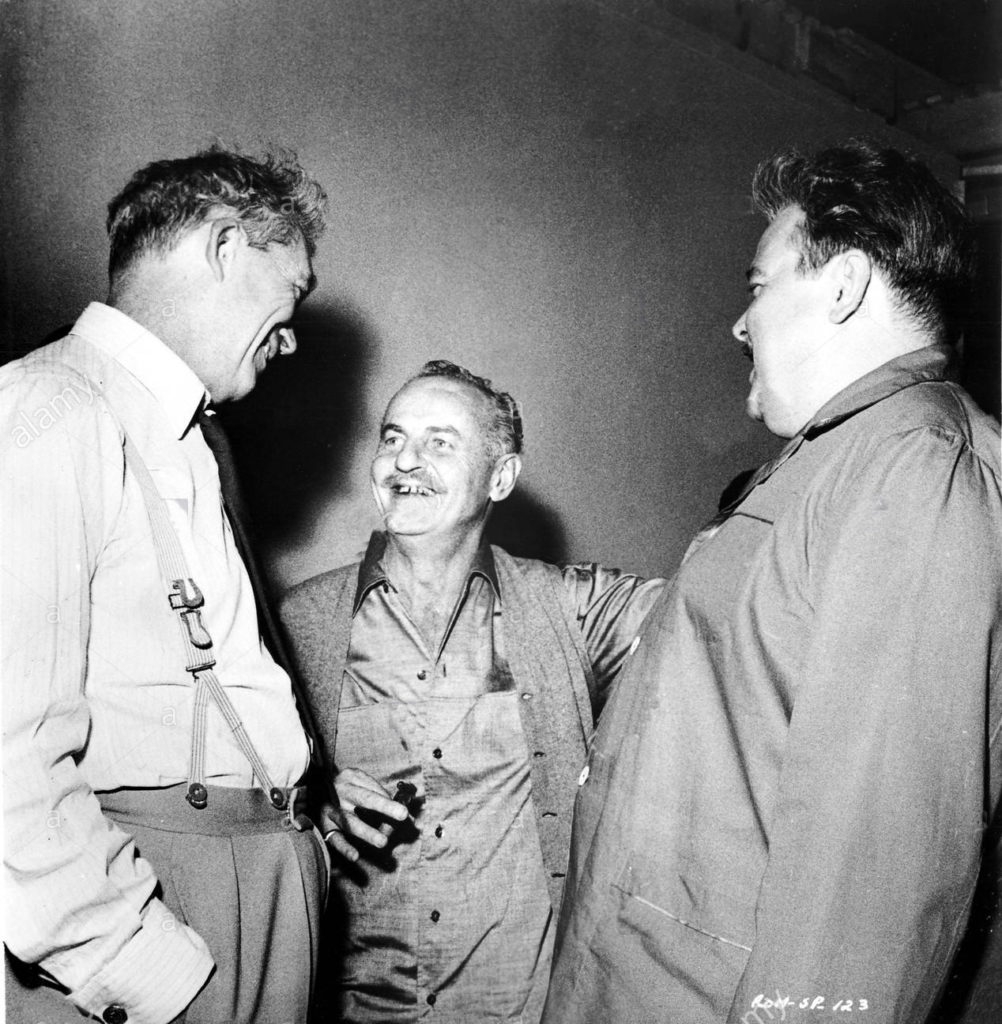
Huston, Zanuck and Welles On “Roots Of Heaven”
WELLES 2: Welles and Zanuck
Welles had just completed his part in the massive Technicolor 20th Century Fox Tyrone Power movie, THE BLACK ROSE then shooting in North Africa (where Welles was struggling to shoot his self-financed Othello). Once the North African location shooting on the Black Rose was completed Welles literally walked off with every costume and prop from the film that he thought that could be used on his film as the man had absolutely no money and therefore had no shame because he needed to make his film.
A short time later, Darryl Zanuck head of Fox and the THE BLACK ROSE’S director, Henry Hathaway, are in Zanuck’s hotel room getting ready to do go somewhere. Suddenly Zanuck receives a phone call. It’s Orson Welles in the hotel lobby. Zanuck tells Hathaway that “it’s Orson and he probably needs money.” So Zanuck plans with Hathaway to sneak out of the hotel the back way and avoid Welles.
So, they take an elevator to the lobby but before they can sneak off Welles spots them from the other side of the Hotel Lobby. Welles makes a dash across the Hotel lobby that would have gotten him in the Olympics. He then drops to his knees in front of them and pulling out his empty pants pockets pleads to Zanuck, “Darryl, I am completely broke. I have no money and I’ve got a cast and crew waiting to be paid and I have no money to pay them. Please Darryl, I’m am begging you, you have to help me. You are looking at a desperate man.”
Zanuck takes a deep breath and realizing he’s trapped takes Welles and Hathaway up to his room. In the room he writes Welles a personal check—I think either 25 or 50 thousand—but he tells Welles that he must accept a role in a Fox film sight unseen. Check in hand Welles, announces, “Anything. I will do anything you want. How could I possibly say no to you, Darryl? You have saved me.”
So, sometime later Welles received a script for something called KANGAROO. He read it and sends it back to Zanuck with a note saying that he could not possibly appear in such a piece of shit as it would definitely damage his acting career worse than it has been already.” (Richard Boone would eventually play the part and not long after was relegated to television.)
Zanuck is of course outraged but, a few years later when Zanuck has gone into independent production and is shooting THE ROOTS OF HEAVEN in Africa. (The making of that film could be a film) The film doesn’t have any real stars (Errol Flynn-his career as a top star now history is top billed.) So, Welles knowing that now Zanuck could use Welles’ help by attaching his name to the film agrees to do a small part as payment for the money Zanuck gave him when he needed it. Welles is absolutely wonderful in the film and provides one of the movie’s high points.
And that is Orson Welles. There was no like him and there never will be again.

WELLES 3: Welles and Harry Cohn.
While Welles was making LADY FROM SHANGHAI he discovered that studio head Harry Cohn had bugged his office with not one but three microphones. Instead of being insulted Welles was amused at the idea that anything he had to say was so important that Cohen needed to bug his office. In fact, he thought it was rather a compliment. So, Welles decided to have some fun. Every morning when he walked into his office he would announce for Cohn’s benefit, “This is today’s announcement: Good Morning. This is the mercury office—we welcome you to another day of fascinating good listening.” Then at the end of the day he would sign off with music and announce, “Tune in again to us tomorrow morning.”
Truth is Welles liked Cohn because of Cohn’s complete lack of pretention. Cohn was a dominating, vulgarian who didn’t have a phony bone in his body. At all times what you saw was Harry Cohn and nothing but Harry Cohn.
Also, Cohen pretty much let Welles cut LADY FROM SHANGHAI the way he wanted but just cut down two scenes, the fun house and Mandurian Theater. Cohn also asked Welles to remove some of the experimental sequences and put in more close-ups of Welles’ wife Rita Hayworth. In other words, which is hard after watching the film, Welles made it a little more conventional. But, Welles did the cutting and it was his film saying the things he wanted it to say. In fact he had brought the film in under schedule and under budget but the year of tinkering it required shot up the budget and didn’t do Welles reputation much good. The only thing that wasn’t Welles as that the awful score that—as Welles put it—Cohen hired a second rate composer to do and was downright stupid. So, due to Harry Cohn when you look at LADY FROM SHANGHAI, you are seeing Wells film if not exactly how he made it but enough of it that he could call it his. You just need to turn off the sound.

WELLES 4: Welles and David Selznick.
Welles considered David Selznick an intimate if “uneasy” friend. Selznick wanted Welles to narrate the145 or word or so opening of DUEL IN THE SUN:
“Deep among the lonely sunbaked hills of Texas, the great and weather-beaten stone still stands. The Comanches called it Squaw’s Head Rock. Time cannot change its impassive face, nor dim the legend of the wild young lovers who found Heaven and Hell in the shadows of the rock. For when the sun is low and the cold wind blows across the desert, there are those of Indian blood who still speak of Pearl Chavez, the half-breed girl from down along the border, and of the laughing outlaw with whom she here kept a final rendezvous, never to be seen again…And this is what the legend says: A flower, known nowhere else, grows from out of the desperate crags where Pearl vanished. Pearl, who was herself a wild flower, sprung from the hard clay quick to blossom and early to die.”
There was only one man who could make this over the nonsense of a narration work and that was Orson Welles and Producer David Selznick knew it. So, when David Selznick asked Welles how much he wanted to speak those 145 words into a microphone which would be all of five or ten minutes work, Welles said $35,000 dollars. (He was desperate for money, trying to buy the negative for IT’S ALL TRUE FROM RKO) Selznick was shocked and said that was absurd. So Welles countered with 25,000 and Selznick said, “Why do you want to do that. You’ll just pay it away in income taxes. Let me give you a really nice present.” Welles agreed and spent the ten minutes at the microphone.
So, expecting maybe a Rolls Royce or impressionist painting, when Christmas came around he finally got his present from David Selznick. It was a box containing two antique dueling pistols. (Get it, DUEL In the Sun) A card accompanied the present announcing that their value from an antiquarian point of view was $125. So, what wells Welles to get even with David for this joke, was every Christmas to send David two glass pistols with candy inside and then tell everyone in Hollywood about it and they all had a good laugh at David Selznick’s expense. If there was thing that David Selznick didn’t like was people laughing at him. He could be the most charming and endearing person but—and many people learned this the hard way—you didn’t want to get on his bad side. So Welles got his revenge.
But as I mention the two were good friends. So one night they were both over Walter Wanger’s house and David got himself soused. I mean drunk. They were talking about plays that would make good films and someone mentioned the play THE YELLOW TICKET. David had never heard of it or was too drunk to hear the title clearly and so asked, “Who’s Yellow?” Welles, who obviously wasn’t as soused, immediately spoke up “Oh, David you are.” As I mentioned David did not like to be made fun of. So Mr. Selznick stood up, put on his eye glasses so he could see what he was doing and then took a swing at Orson Welles, who fortunately for world cinema knew how to duck a punch. And that’s who Orson Welles considered an intimate but wary friend. It makes you wonder what he thought was an enemy.

WELLES 5: ORSON WELLES’ MACBETH
Let’s get this straight; with this film in no way was it Orson Welles’ intention to make a masterpiece. For him it was just an experiment. Hollywood thought he wasted money and always went over schedule and Welles was going to prove them wrong and do it in a big way.
The geneses of the film is one of the interesting Hollywood stories. After LADY FROM SHANGHAI finished shooting and went into the editing room, Rita Hayworth’s last attempt to make their marriage work failed and she—in a nice way—asked Welles to get the hell out. She still loved him—every woman who had was involved with him would continue to love him. He was truly one of a kind.
An aside: Welles comes to Hollywood and makes Citizen Kane. But for Orson Welles that wasn’t enough. The most beautiful woman in Hollywood was Dolores Del Rio and so low and be hold they were soon a couple. The affair went on during the making of Kane and through Ambersons but the affair cooled after Welles came back from South America during the summer of 42. On to new things, Welles saw a photograph of Rita Hayworth—one of the greatest Sex Goddesses Hollywood ever produced—and like he did with Del Rio he set his sights on her and guess what, he married her. The headlines were “The genius marries the love goddess.” They had three months of bliss but then, as with all passionate affairs that transfer into a relationship the troubles started. Rita Hayworth was immensely needy and Welles was basically someone who needed to be mothered. So as neither could do it for the other. On again. Off Again, the marriage was over and Welles moved out.
So, Welles moved in with Charles Feldman who remains one of the most interesting—no, fascinating—men ever to come out of Hollywood. A lawyer by education, powerhouse agent by profession, he was the only agent in Hollywood who was allowed to produce. He was also a womanizer on the scale of Welles. One can only imagine the womanizing that went on in that house while the two lived there together.
Now Feldman had a multi picture contract with Republic pictures. At the time Republic was a one star studio and that star was John Wayne with the bulk of its product being bread and better B-Westerns. Occasionally Herbert J Yates who ran Republic would make a prestige film.
Shakespeare had been a pretty dead issue in Hollywood for the ten years following A MID SUMMER’S DREAM and ROMEO AND JULIET lost their respective studios millions. But Lawrence Oliver’s HENRY V had just been released in the states and was making a ton of money. So Shakespeare was back in fashion and who to better make a Shakespeare film than one of the great American Shakespearian actors—Orson Welles.
So Feldman cut a deal. Welles would make 100,000 to produce, direct, adapt and star in Macbeth. But if Welles went over budget, the overages would come out of Welles salary. Between the IRS, alimony payments and a high living life-style, Welles’ finances were a disaster and he needed every cent of that money.
But the budget that he had, with the cast and the size of the production, to bring the film in on budget on he would have to do it on a 21 one day shooting schedule. That’s three and a half weeks. It was an absolute impossibility and that was the challenge for Welles. He liked doing the impossible.
So, he got his cast together and he accepted an offer to direct a play at the Utah Centennial Festival. This is where you have to say that he man was brilliant. The play was going to be Macbeth and it be a trial run for the film. 1st, his actors would have to have their parts memorized, second he would be able to see how the actors performed together and third figure what would and wouldn’t work on film. So, Welles, carted out his Hollywood cast to Utah, rehearsed them and the play ran for four performances. By the last performances Welles already had his film planned out. Also, the reviews of the play were laudatory among the best he ever received for his work on stage.
Back In Hollywood he now rehearsed the cast for the film and when scenes were perfected he recorded them so that the cast would mouth the words when the film was being shot giving Welles the latitude to provide directions while the camera was rolling. Also, there would be no muffed lines and he could do long complicated takes without worrying about actor messing up a line. He would just need to choreograph them.
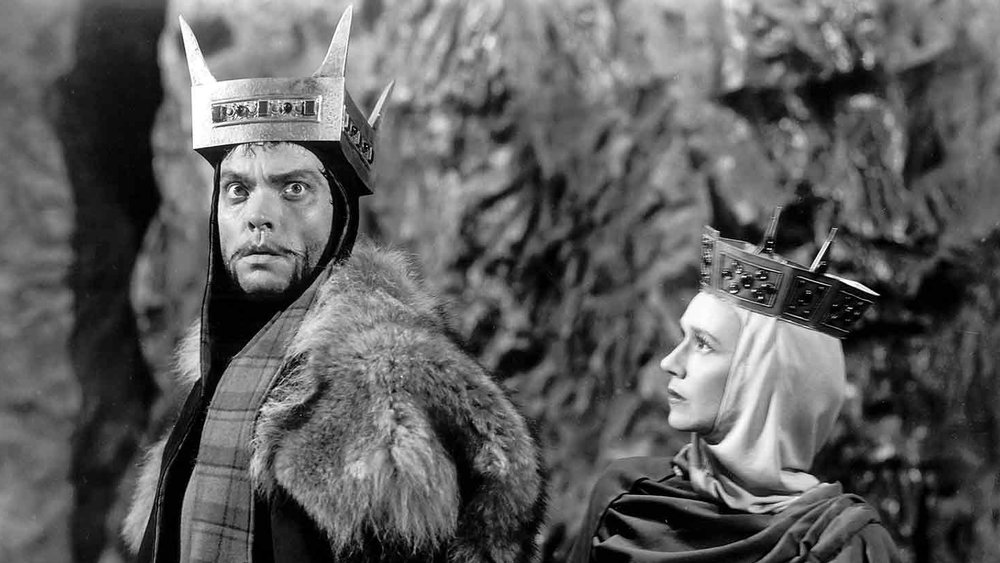
Also his Macbeth would not be Renaissance. It would be 11th century Scotland with the actors speaking Shakespeare in an Irish Brogue. It was audacious and Welles planned to do it all in 21 days. At Republic he was given two sound stages and built these dark brooding theatrical sets. As he didn’t have a lot of money they were basically re-built Republic western sets cobbled together with Welles’ additions. Even his crown was made of cardboard but Welles’ brilliant cinematography made it all work.
In 21 days—because of all the pre-production work—he had done and especially the pre-recordings, Welles did the impossible he made a film that looks like four times what he spent. It was the talk of Hollywood and the head of Republic told him that in all his years in the business he had never seen anything like it and praised Welles to the sky.
During the production Welles was getting next to no sleep, yet was a dynamo on the set. (Whenever John Wayne had a break in filming he could be found on the set watching Macbeth being made. He had never seen anything like it before. In fact, no one had.)
To show you how inventive Welles was, Republic extras were known to be among the laziest in the industry. But, he needed the crowd of soldiers to rush the castle like men out for blood. There was no way he was going to get this out of those Republic extras no matter how many takes he would shoot. So, Welles had several cameramen holding hand held Mitchell’s dispersed in the crowd so they could shoot close ups. He he covered their backs so from the rear they looked like extras. Then he arranged the actors in a certain way so, to leave the set they would have to move past the castle. Then he called lunch and those lazy extras came to life and ran to (and then past) that castle exactly the way Welles wanted them to do it.
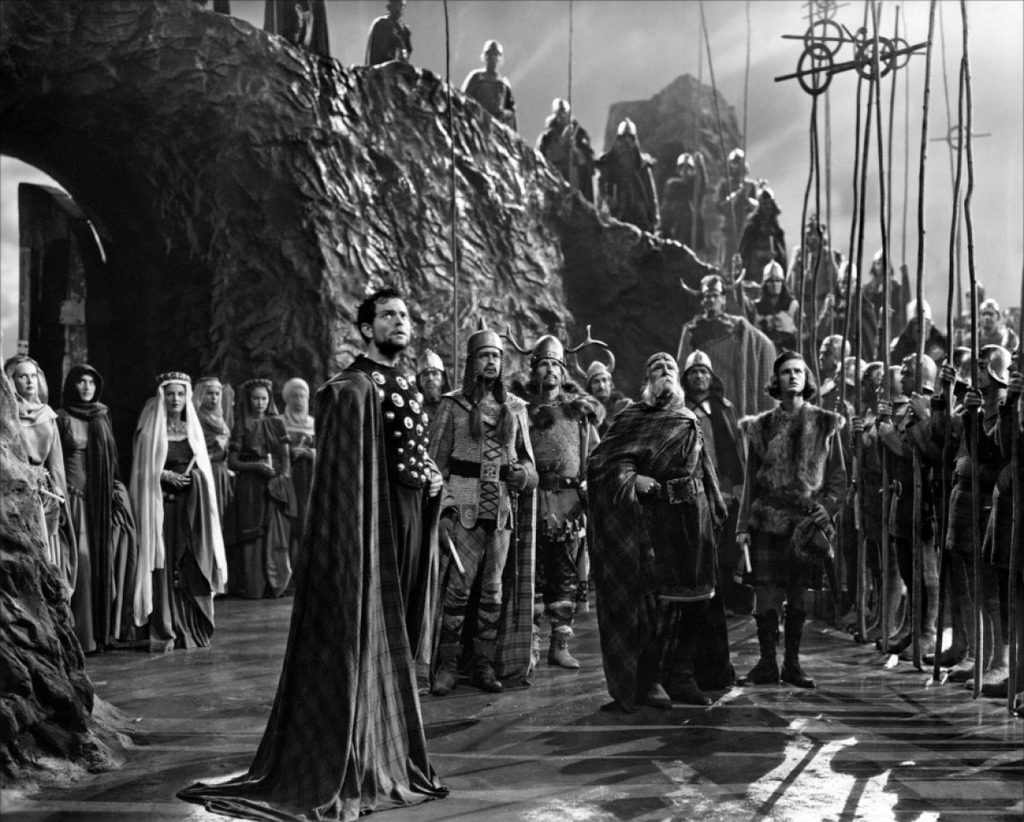
After Welles assembled the first cut he was off to Europe leaving the editing to his assistant. Welles had received an offer of $100,000 to make BLACK MAGIC in Italy (by the way, one of the worst films ever made.). Desperate for money, any money, he was gone before anyone knew it especially the head of the studio who expected Welles to edit his film. There were some editing problems so Republic sent an editor with work print to Italy so Welles could edit it there. Knowing how bad Black Magic was, instead of working on Macbeth, he had the editor work on BLACK MAGIC and when the editor returned to Hollywood the film still wasn’t finished.
But eventually it was and Republic decided to open it in Boston as a Roadshow—reserved seats, programs the whole package—exactly as Olivier’s Henry V had played. And it did open and it immediately dropped dead at the box office.
So the studio took the film back for re-editing. First thing they wanted was to re-record and eliminate the Brogue. Did Welles have a problem about this? Absolutely not. They wanted to take 20 minutes out? Did Welles have a problem with that? No way? He just wanted to do it himself and not have it mucked up by a studio hack.
So finally, three years after filming it went into general release and even in that version it dropped dead at the box office.
But, by this time Welles was in Europe—having by circumstances—become an independent film maker and was directing, producing, adapting and acting in Othello; a film shot on locations and not sound stages. As Dark as Macbeth was, Othello was sunny and light.
Eventually the roadshow—full length print was found—restored and is now available on Blu-Ray.
The reason why it failed at the box office is that it was a film, essentially made for Shakespeare aficionados. It’s dark, gloomy, and slow paced. But if you are familiar with Macbeth—which I am—it is an utterly imaginative interpretation of the play that proves very rewarding. Is it definitive; no. Is it a successor to Citizen Kane, not by a long shot? Is it fascinating; you bet!
Also, and this is of no little importance, in its complete version, it’s Welles first film since Citizen Kane that wasn’t tampered with and exists as Welles made it. And considering what has happened to so many of Welles films this is no small thing.

WELLES: TOUCH OF EVIL
My favorite Orson Welles movie is Touch of Evil. I personally consider it his best film because in many, many ways the film is a reflection of Welles not so much in content but in terms of the sheer fun it is to watch as a reflection of Welles the film maker. Watching that film I have as much fun as he had making it as it takes (me at least) into the sheer joy of movie making. So a few anecdotes from that movie.
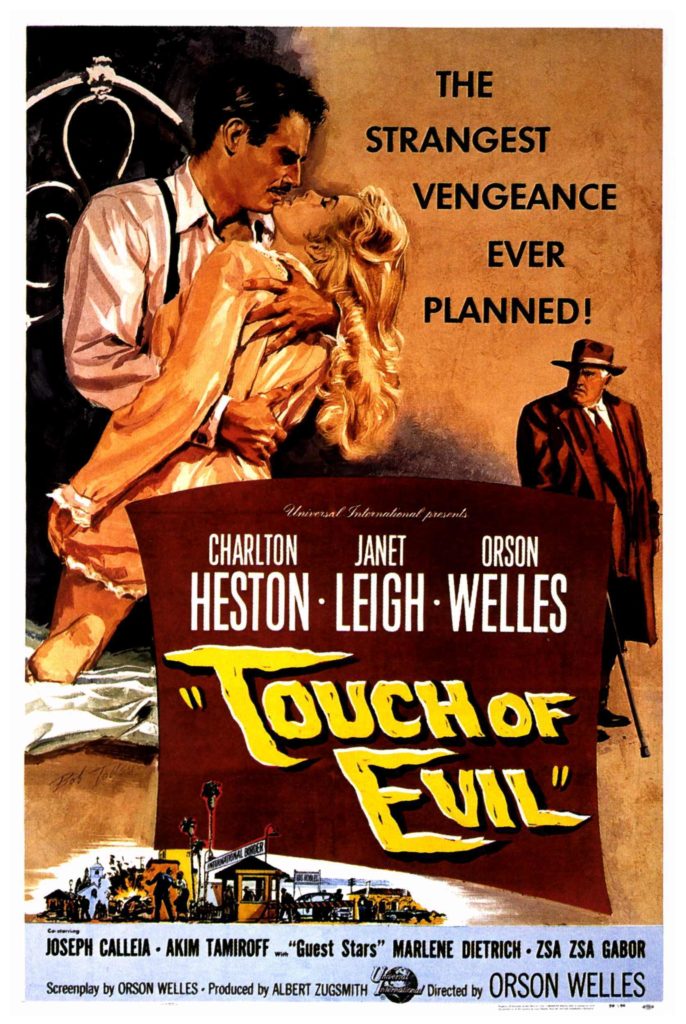
#1
After nearly ten years in Europe attempting (with great effort) to make self-financed or independently financed movies, Welles was back In Hollywood acting in some pretty crummy movies. He needed the money and he still had standing name as an actor although Welles as a Director in Hollywood had the curse of Caine on it.
He agrees to do this perfectly awful cop movie for Universal. I mean it was less than crap. So, universal goes looking for an above the title star and they happen to call Charlton Heston. The first thing they say is that Orson Welles is attached. Heston then asks whose going to direct but they don’t know yet. Heston says, “You know he is a pretty good director.” Figuring that if they have Welles for a director they’ll have Heston, they call Welles and ask him to direct. He agrees but says he has to re-write the script. They say fine but then they will only pay him for acting. He will have to direct and write without payment. Welles, who hopes this might be his chance to direct in Hollywood again, agrees. They immediately call Heston and as soon as he hears Welles is directing he agrees telling them they don’t have to bother sending him the script just call his agent and make the deal. Welles had three weeks to do the re-write which was writing another script and so, got himself in a room with five secretaries and re-wrote the script in three weeks literally going into production while the ink was still wet on the script. (Well the typewriter ribbon) They didn’t call the man a genius for nothing.
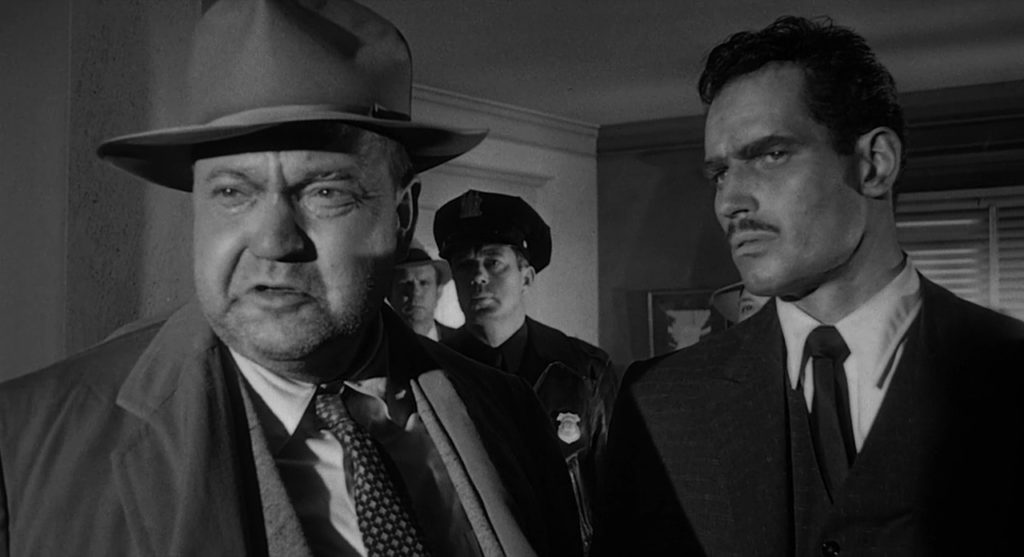
#2
They were only two or three studio sets for the film and the rest was shot in Venice California. So, the first day shooting was in the apartment set at the studio where they find the dynamite. It’s I think 14 pages of script which usually adds up to four days of shooting. Wells arrives and sets up the lights, rehearses the actors but by lunch he hasn’t shot a foot of film. The studio execs are getting nervous and calls are being made announcing it’s 12 and he hasn’t shot a foot of film. Same for 1:00, 2:00, 3:00, 400 and by five the same thing and the studio is going nuts. This has never happened and it’s a studio nightmare as they see the budget ballooning by the second. A shooting day ends at 6:00 and it isn’t until 5:45 that Welles finally roles the camera. Worrying about the shooting schedule none of them had watched what Welles was doing. In that small set he had been setting up a single take scene much like he did in AMBERSONS but in a much more confined and difficult space without the set being prepared for it. It was I think a six or seven minute scene and at 4:51 he calls cut and then does a second protection take. Finished at just before 6:00 he shouts cut and print and announces that they are now 3 days ahead of schedule. Heston said it absolutely blew the minds of every exec at the studio and that is exactly what Welles wanted to happen. From then until the film went into the editing room it was THE film at Universal that everyone wanted to know about. The screening room where the exec watched dallies was usually empty, for the TOUCH OF EVIL footage it became standing room only. At that studio and during that shoot Welles’ name had become magic again.

#3
As soon as you see Welles arrive in his first scene in that costume in that face which looks like a truck ran over it, you know exactly how much fun this film is going to be. Welles wasn’t that heavy at the time and used padding as well putting on a ton of make up to make that incredible face. So, and this is when they were still shooting in the studio, he had a party in the house he was staying in one night after shooting. He invited all his Hollywood friends: stars, actors, writers, directors—and even studio heads. They might not let him direct but they loved being around the man as he was so much fun to be with. Because he’s shooting late he arrives at the party in is Hank Quinlan make up. Now, many of these people haven’t seen Welles in ten years and when they saw him looking like this they must have thought he was a total wreck and not to offend him, all of them tell him one right after the other that he looks great. Welles is thinking, they must really think I’m a complete disaster and out of pity are trying to make him feel better. He had a good laugh over this one and told the story for years. I am smiling just re-telling it.
#4
To give an idea how creative he Welles was, during the filming and how exciting it was to work on the movie, before TOUCH OF EVIL, scenes in cars were always shot in front of a process or blue screen in the studio as it was too expensive and took too long to shoot inside cars on location. Not on this film. Welles took out the wind shield of Heston’s character’s car, mounted a camera on the hood, gave the control to start and stop the camera to the actor in the passenger seat, told Heston to just drive the car and when he was ready do the scene turn on the camera and when he was done shut off the camera. No director, no cameraman, just Heston another actor, the camera and a car. So, Heston did what he was told and essentially directed the scene himself and as he said, it was his first time directing. I mean what director in 1957 would even think of doing that. This was why the dallies were standing room only. Welles was again creating magic. This was the director of Citizen Kane return from the dead.
#5
Welles is taking a piss with Heston in the basement bathroom of one of the location buildings they were shooting in. As he’s peeing Welles looks around and says, this would make a great spot to film a certain scene in. So, he has the cameramen come down and set up while he gets the actor he wants for this scene out of bed and tells him they are shooting there in the middle of the night. He got him there had the costume put on and Welles shoots the scene right then and there. I mean it was that exciting and that much fun for everyone involved in the film as Welles immense creativity spread over everyone there.

#6
When Welles looked at TV he preferred the commercials to the programs as he felt there was more creativity in the commercials than in the shows but one show he did look at was GUNSMOKE and he looked that show because of Dennis Weaver who played Chester. Welles considered Weaver one of the best actors in America—although he was one of the few who knew it—and he wanted Weaver to get into the movies. She he hired Weaver for three days work on TOUCH. The first day of shooting was scripted but when Weaver showed up the next day Welles wanted him to improvise—thus much of Weaver’s performance in the film was improvised as it was being shot. But Weaver was wary of doing this because he didn’t feel he had a grasp of the part. So, Welles shut down the production for an hour and showed Weaver his work of the previous day so Weaver could get a grasp of the part. From that point on it was all improvisation. All that sexually uptight stuff, the reaction to the pot and the general weirdness of the character was Weaver. This was especially true of the scene where he interacts with the Grande gang. None of the actors knew it was Weaver as he was in character on the set. And so as the scene—completely improvised—was being shot the other actors suddenly realized that this weird guy they were working with was actually Dennis Weaver.
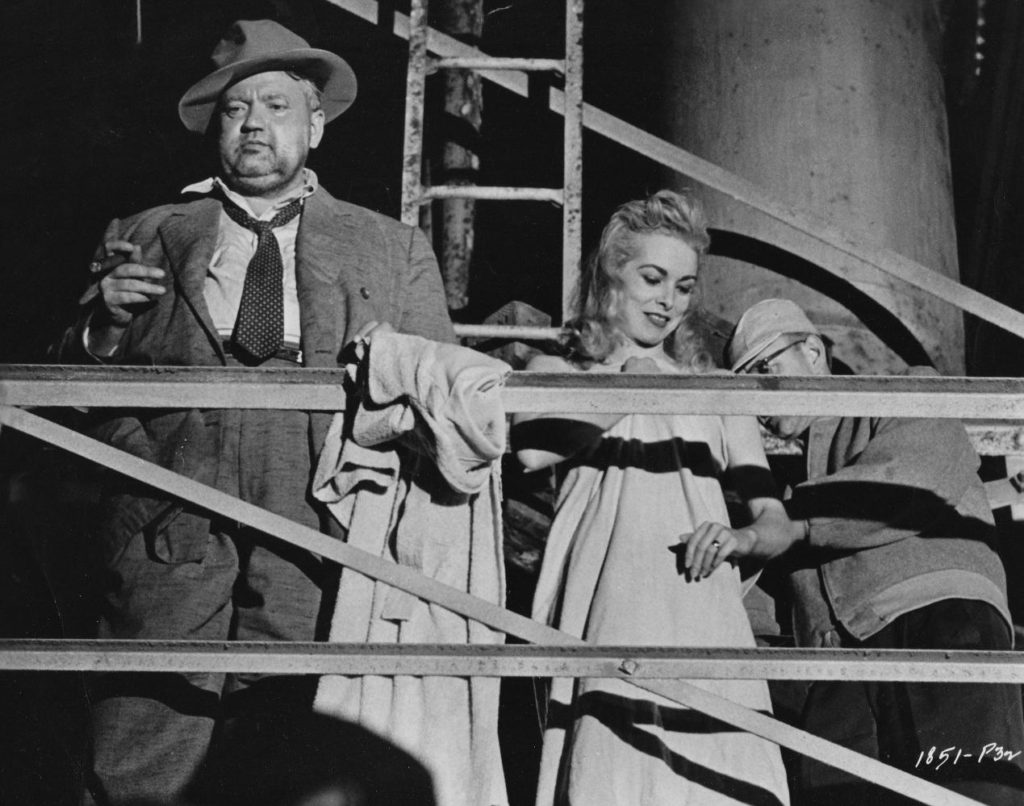
#7
Janet Leigh broke her arm and Welles thought he would use it as part of the character but, instead, decided to have Leigh holding her jacket to hide the cast and hide the cast in other ways. But for the scene in the motel where she is “attacked” he had the cast sawed off, had her play the scene and then the cast was put back on. In the scene where she runs out onto the fire escape in her slip and screams for help. Because they were shooting so fast, Leigh was escorted up the stairs by an assistant director, escorted through a room with a vagrant sleeping in it. The AD made sure to project Leigh if there was a problem—and then Leigh went out on the fire-escape and did the scene. Also, and this interesting Leigh really didn’t have any idea of the story or, when playing a scene, where it occurred in the picture. In some scenes she had to have her hair up and some her hair down. So on a given shooting day Welles, would tell her “hair Up” and then an hour later “hair down.” And that is how she got through the picture.

#8
In the scene where Akim Tamiroff is strangled, Welles wanted the character to bite off his tongue and it shoot out of his mouth. So he had a tray of (I think) goat tongues bought in. Tamiroff was to choose one and then as he was being strangled to spit it out of as if he bit off his tongue. Tamiroff is so disgusted at the idea of putting one of those awful things in this mouth that he refuses. This was obviously not his idea of acting. But Welles persists—remember this was supposed to be a black comedy—and Tamiroff finally puts the tongue in his mouth But it proves just too much and so Welles cut it. Truth is that those bulging eyes were enough. The first time I saw them I was laughing so loud that people had to shush me. They obviously were taking the film seriously while I, of course of course got the comedy in it—that which was left in

#9
Welles calls up Dietrich and says he has a part for her. But she has to be brunette and not a blond. Dietrich says they still have the wig she wore in GOLDEN EARRINGS at Paramount and while there she also picks up a dress and arrives on he set looking exactly like what Welles wanted. What is interesting is that Dietrich always had a thing for Welles, but he didn’t like blonds. But when she showed up in the brunette wigs she sees a tingle in his eye and it appears he was finally interested. Anyway, Welles never told anyone at Universal about Dietrich so when the dallies are shown the execs are shocked when they see Dietrich. “What is she doing there?” So, they call her up and try to work out a deal. She says, “you don’t use my name I am paid scale. You use my name then you pay my rate.” As adding another star name to the film wouldn’t hurt, they pay Dietrich a great deal of money for her four day’s work. Of note is the fact that Dietrich considered her last scene in the film her best work as an actress. Here are her lines.
Tanya: Isn’t somebody gonna come and take him away?
Schwartz: Yeah, in just a few minutes. You really liked him didn’t you?
Tanya: The cop did… the one who killed him… he loved him.
Schwartz: Well, Hank was a great detective all right.
Tanya: And a lousy cop.
Schwartz: Is that all you have to say for him?
Tanya: He was some kind of a man… What does it matter what you say about people?
The last line could have been description of CITIZEN KANE.
#10
Welles had four months to deliver his director’s cut. He took four. The studio took a look and they weren’t very happy as they found the film confusing and needed Welles to come back for some additional editing and reshooting to make the film more discernable for an audience. What Welles had delivered was a black-black comedy that told a story in a way these people thought an audience would have a difficult time following. But Welles had suddenly disappeared. So they called Heston and asked if he knew where Welles was. Heston was in the middle of making THE BIG COUNTRY and said he didn’t know.
Without telling anyone Welles had gone down to Mexico to try and raise money for a film. You don’t just disappear like that in Hollywood. The studio was very irate and basically from that point on shut him out of the editing room and had another director do these additional scenes. Heston was given a call and told to show up the next day for the reshoots but at Welles request refused to show up and the studio charged him $8,000 as that is what it cost them for a shooting day. Heston eventually did the reshoots because his agent told him if he didn’t he would be kicked out of the Actor’s Guild.
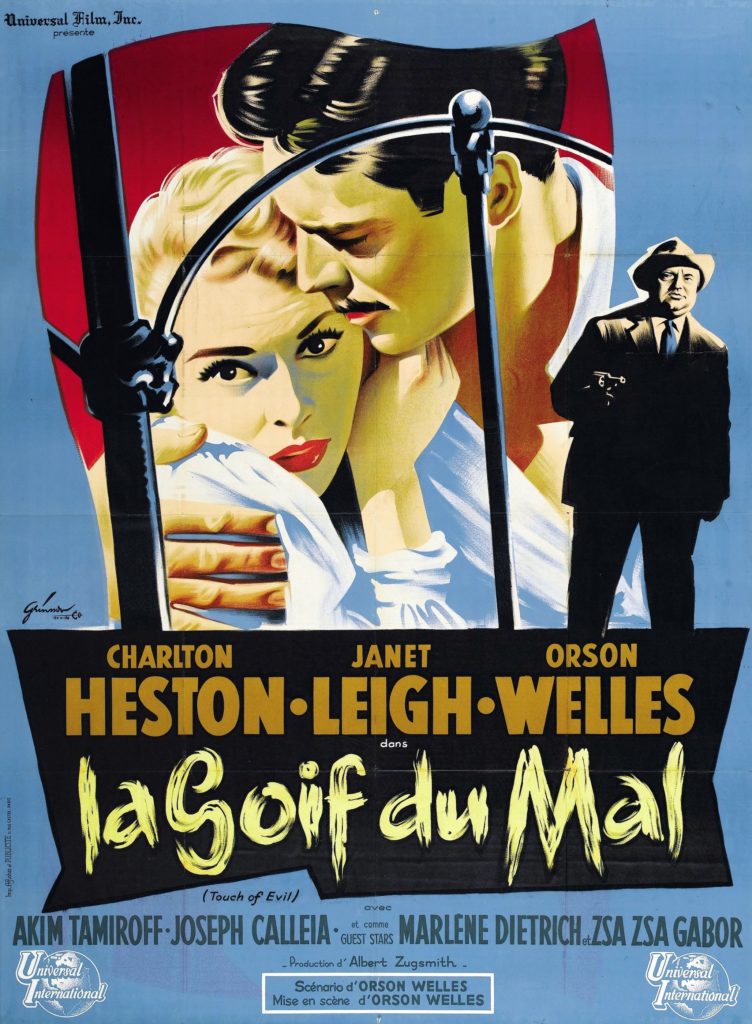
#11
Welles saw the preview print and realized that they had cut out all the funny stuff with the Grande family and the black comedy aspect of the film was gone. Nevertheless he saw that there were ways to improve the film they did have. But, persona non grata at the studio, he wrote a 50 page memo describing what needed to be done to improve the film and sent it to the studio. It was of course ignored and sat forgotten in a studio file for over 25 years. Eventually the film was cut to 96 minutes and released in the states with little fan-fare where it pretty much dropped dead at the box-office. In Europe it was a different story. It ran at a Paris theater for over a year and was well received thoughout Europe. In fact the head of European distribution insisted on submitting it to The Brussels film festival where it won the top award. The poor man was fired soon after because having been written off in the states, this would be proof that the studio heads didn’t know what they were doing. So, having been embarrassed by him, a man with the company for 20 years was given the door.

#12
OK, the 50 page memo is discovered and floated around for a while and finally in the late 90s Universal agreed to re-edit the film to the specifications of Welles Memo in hope of a possible re-release. They had found the preview print which was longer than the release print and allowed them to restore scenes taken out and they removed all but one of the reshot scenes because they didn’t have the original material for the scene. Fortunately, when Universal had sent the film to Europe, Welles’ incredible one take opening shot—which had credits put on it in the states—didn’t have them on it when sent to Europe so that each of the countries could put the credits on it in their own language. They can now run the shot without the credits. The sound was also changed to Welles specifications, there were some reshuffling of scenes and footage added. It was finally the film as Welles wanted it to be. (Minus all the comedy of course although some of humor is still there. Those think the fead Grande’s eyeballs.)

#13
Now what is interesting is that the restored version is still the same film as the 96 minute version. It’s a litter clearer and more interesting and more of the humor comes across. What is amazing is that when I first saw it, my initial thought was that it was indeed the same film but there was just more of it. In other words they could tear a Welles film apart but an Orson Welles film is so good that it is just impossible to completely ruin it because Orson Welles comes through no matter what they do and no better example of this is, of course, Touch OF Evil.
#14
Heston said that Welles wasn’t the best director he ever worked with but he was the absolute most creative. His mind flowed with ideas. Robert wise said much the same thing. It reminds me of Keaton Verses Chaplin. Not in terms of comparing their finished work which is apples and oranges. That’s not what I am talking about. I am talking about their process. Chaplin would labor over his gags. He would take a single idea and over time develop it and eventually perfect it. Keaton could come up with ten ideas in that many minutes, He was doing a Candid Camera in the 60s and Alan Funt the director-producer of the show said that all you needed to do was give Keaton a prop and he could spent all day coming up with ways to use it and everything he came up was funny.
Welles was much the same way. When he did THE STRANGER he worked much like any other “Hollywood” director and he was bored to death. It was like he was stifling himself. He needed free reign in an atmosphere where he could actualize all the ideas that would pop into his head as he did in TOUCH of EVIL. Wise said that Welles one fault was that Welles was undisciplined and that is what made the studios so frightened of him. He just didn’t do things that everyone one else did. So, it wasn’t that the studios wanted to destroy him—some of his best friends were heads of the studios. It was that they were scared of him; frightened that they couldn’t control him and that his finished product would be so off-beat that it wouldn’t find an audience and ultimately lose money.
You should read about IT’S ALLTTRUE. He spent 500,000 dollars and came back from Brazil with gads of Technicolor footage that even he couldn’t figure how to put to together. He spent years working on it trying to get studios to buy the footage from RKO. He even worked out a deal where RKO would sell it to him for 200,000 dollars but he could never get up the money. It was this incident that made the studios so scared of him. Later this wasn’t true as he brought his films under on schedule and on budget but the stories of his waste persisted and Heston said it was his undoing at the studios. On the other hand as a person Welles was really liked by almost everyone in town despite him sometimes being overbearing and difficult, he was often a delight to be with. If I had to use one word to describe Welles, it would be FUN!
The interesting part of TOUCH OF EVIL is that while it was being made Universal was offering Welles a four picture contract and Welles believed that this would be his second start at a directing career in Hollywood. And he was now ready for it. He had mastered the medium. But as soon as the studio saw that first cut and he wasn’t around to “fix it,” they just wrote him and the film off. It became a replay of AMBERSON where the film was recut by others and his vision altered. Welles was so surprised as they had absolutely loved the rushes and then it turned out to be one of the biggest disappointments of his career as his second stab at a Hollywood evaporated in a moment and no one was more shocked by this than him.
It should be understood that Welles had so much going for him with KANE—he had all those departments at the studio and Greg Toland of course to help him realize his film—as he was just a novice and was learning as he went. But what an achievement. In the intervening years he had become a master of his craft and TOUCH OF EVIL was all Welles. He had some good technical people but no budget and no special affects except the makeup he wore for that incredible face he created for himself. This really was ORSON WELLES: TOUCH OF EVIL. It was a one man show from beginning to end.
This is what Welles Told Barbara Leaming about Technical abilities as a filmmaker at this point in his career: “You see the one thing on which I am totally without self-doubt is the technical side of the theater, radio and movies. And I never did anything that wouldn’t work. I did things that people didn’t like. But any story you hear about something not working: not true. I am the only director in the world that I’ve ever heard of, or anybody that I’ve ever talked to hears of, who comes on a set and puts his closed fit in a certain position in the air: this will be a 40 here. Without a viewfinder, without anything—and I know exactly what will work. I am the absolute technical master of the medium. I have no shame in saying it. So if people say something doesn’t work, they don’t know any better. That’s all I can say.”
And Frankly. That’s all I have to say.